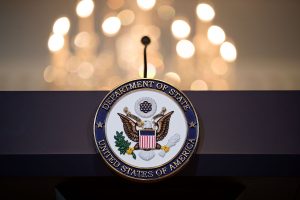Diplomacy as a tool of first resort

WASHINGTON, DC – (Photo by Drew Angerer/Getty Images)
In many instances in the decades since the Cold War the United States has privileged the use of military force over diplomacy. Although the Department of Defense “is the best-trained and best-resourced arm of the American government,” not all crises and problems can or should be solved with military force (Nye, 2011, xiv). The militarization of U.S. foreign policy creates an environment that allows for more bellicose posturing and makes diplomatic solutions appear less desirable. If power between state and non-state actors in the international system is relational (the scope of power), so too is power between a state’s government agencies. By increasing congressional appropriations to the Department of State, diplomacy can be made a veritable tool of first resort that will employ smart power and lead to more responsible engagements abroad.
Lessons from the Cold War for confronting China
As was the case during the Cold War, the U.S. is once again facing off against a rising superpower as well as a growing sphere of communist and authoritarian influence (Rachman, 2020). China’s diplomacy and economic projects such as the Belt and Road Initiative have extend its influence into Africa, Latin America, Asia and the Middle East (Ikenberry, 2008, 26). While the Society Union rivaled the U.S. as a military competitor, China is emerging as both a military and economic rival (Ikenberry, 2008, 26).

https://www.ft.com/content/c545a2aa-3821-11e8-8b98-2f31af407cc8
The Trump administration has confronted the rise of China by triggering a trade war, imposing sanctions on Chinese companies and businesses, increasing military tensions in the Pacific and the South China Sea and utilizing confrontation language in targeted speeches. In short, these tactics amount to an aggressive policy of brinkmanship in which the U.S. has addressed China’s rise alone and in a non-diplomatic fashion. The incoming Biden administration must remain adamant and focused on China, but it must confront it with support from Western countries such as the European Union and liberal-democratic institutions.
In the aftermath of WWII and the subsequent rise of the Soviet Union, the U.S.’s Marshall Plan integrated vulnerable European countries into the Western order (Ikenberry, 2008, 27). Following the collapse of the Soviet Union, the Western order allowed a unified Germany and a wave of formerly communist countries to integrate into its democratic institutions and free markets (Ikenberry, 2008, 27). The U.S. must follow a similar precedent when confronting China and utilize the incentives of Western institutions to promote economic integration. If China intends to become a true world power, it must join the World Trade Organization and the U.S. can utilize its role as the leader of the Western world to dictate the terms of China’s participation (Ikenberry 2008, 32).
The Biden administration must place more emphasis on its alliances with the West and not confront China on its own. China could surpass the U.S as the sole superpower, but not the entire Western world (Ikenberry, 2008, 36). Isolationism and tariffs will only serve to alienate and deter China’s integration that would support U.S. economic interests. However, such a strategy should not be equated to being soft on China. Economic liberalism does not guarantee democracy and social liberalism. China continues to commit gross human rights abuses in Hong Kong and the mass imprisonment of the Uighur Muslim minority in Xinjiang. If the U.S. wants to reemerge and confront China as the leader of the free world, it cannot ignore these travesties for the sake of economic integration.
Cold War to COIN War
In light of the recent developments in the construction of warfare, new strategies to combat the growth of insurgency must be developed. Cold War strategies created to combat insurgents showcased in the Vietnam conflict highlight how ineffective the application of conventional military strategies are as guerrilla forces effectively prevented a U.S. victory. Therefore, U.S. officials must continue to develop counterinsurgency strategies that prioritize relationship building with local communities while remaining as un-invasive as possible. Considerable effort and resources have been poured into

https://www.wearethemighty.com/mighty-trending/4-ways-the-wars-in-vietnam-and-afghanistan-are-the-same/
eliminating threats rather than undermining their enemies platform and support. If the U.S hopes to find victory in a modern warfare setting they must adapt to the modern combatant and engage in the local politics creating a coalition of support. Moreover, in order to maximize impacts in regions with insurgencies the U.S must continue to invest in the infrastructure of these communities, providing an attractive alternative to insurgent activity.
